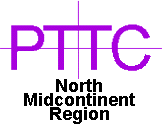
First Quarter 2000 |
February Workshop Summaries
Advances in Well Stimulation
February 9, 2000
The North Midcontinent Resource Center - PTTC cosponsored
a technology workshop with the Wichita SPE Chapter Wednesday,
February 9th, 2000. The half-day workshop began with a luncheon
meeting at the Petroleum Club and extended into an afternoon
technology workshop titled "Advances in Well Stimulation".
Attendance was good with 61 participants from Kansas, Missouri,
Oklahoma, Colorado and Texas. The agenda featured Carl Montgomery
from ARCO, Bill Johnson from Halliburton, George Waters from
Dowell/Schlumberger, Larry Britt from NSI Technologies and Ken
Barker from Baker Petrolite. Topics discussed were; carbonate
acidizing, novel fracturing techniques, reservoir completion
optimization, extreme overbalanced perforating, near wellbore
stimulation and recent advances in non-traditional stimulation
and completion techniques. This workshop provided an opportunity
for operators, engineers and geologists to learn new stimulation
technologies being applied in the midcontinent area. Comments
from operators were favorable, including, "It helped me
direct my customers to people and/or information that helped
them obtain optimum results." Most liked the half-day format
and felt that the workshops and case studies were the most favorable
tech transfer method. Additional workshop topics requested by
operators were: water control in producing wells, completion
design, Kansas well stimulations and results, 3D Seismic developments
and case histories, horizontal, coiled tubing, and log analysis.
Reservoir Characteristics of Morrow/ Incised
- valley Fill Plays
February 16, 2000
The North Midcontinent Resource Center - PTTC conducted a
workshop "Reservoir Characteristics of "Morrow/Incised
Valley Fill Plays" February 16th , 2000 in Wichita,
KS. There were 44 in attendance from Kansas, Oklahoma and Colorado.
The workshop involved presentations on various geologic, log
and core petrophysical and engineering aspects of IVF reservoir
systems in the Morrow, Cherokee, Chester, Tonganoxie, and modern
analogs. The sequence of talks provided analysis of these systems:
1) within a sequence stratigraphic framework, 2) reservoir description
for Morrow, Cherokee, Douglas and Chestererian IVF systems, 3)
identification of IVF characteristics using seismic coherence;
4) analysis using wireline logs; 5) reservoir core petrophysical
properties; and concluding with waterflooding characteristics.
The following topics were presented:
- Sequence Stratigraphic Framework of IVF Systems by
Dr. W. Lynn Watney - KGS, Lawrence, KS
- Oil and Gas Production From IVF Reservoirs in Kansas
by Paul Gerlach - KGS, Lawrence, KS
- Analysis of Morrow Incised Valley Reservoirs by Dr.
Roderick W. Tillman - consulting Geologist - Tulsa, OK
- Incised Valleys in the Cherokee Group, Southeastern Kansas
by Dr. Anthony Walton - University of Kansas, Lawrence, KS
- Tonganoxie IVF System, Northeastern Kansas and Modern
Estuarine Analogs by Dr. Allen Archer - Kansas State University,
Manhattan, KS
- The Chester Formation in South Eubanks Field by Ernie
Morrison - KGS - Wichita, KS
- Interpretive Aspects of Seismic Coherence and Related
Multirace Attributes by Dr. Susan Nissen - KGS - Lawrence,
KS
- Evaluation of Morrow Reservoirs in the Midcontinent by
Modern Wireline Logging Tools by Willard Guy - KGS -Lawrence,
KS
- Integrated Petrophysical Methods for Analysis of Reservoir
Microarchitecture - Chester Formation, Southwest Kansas by
Dr. John Doveton, - KGS - Lawrence, KS
- Routine and Special Core Petrophysical Properties of Kansas
IVF Reservoirs by Alan Byrnes - KGS-
Lawrence, KS
- Waterflood Characteristics of the Morrow, Stewart Field,
Kansas by Rodney Reynolds, Tertiary Oil Recovery Project,
Lawrence, KS.
Morrow Incised-Valley Core Workshop
February 17, 2000
The North Midcontinent - PTTC sponsored a workshop "Morrow
Incised - Valley Core Workshop" February 17th in Wichita,
Kansas. There were 32 in attendance from Kansas, Oklahoma and
Colorado. Rod Tillman of Tulsa Oklahoma and Allen Archer of Kansas
State University conducted the workshop using cores, logs and
data from Morrow Stateline Trend fields. There was emphasis
on interpretation of facies in core (especially tidal and estuarine
facies), examples of tidal facies and recognition criteria, correlation
of core facies with wireline logs and integration of core facies,
porosity and permeability data and log response.
|